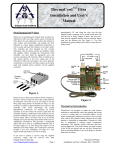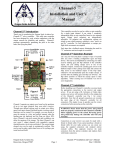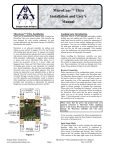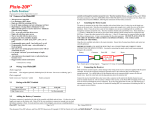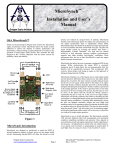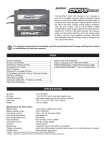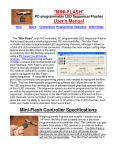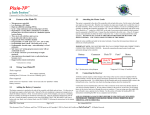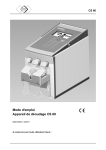Download view - Curtek Systems
Transcript
OWNER’S MANUAL MODEL AIRCRAFT NAVIGATIONAL LIGHTING SYSTEM Please read before operating this system CURTEK SYSTEMS WWW .CURTEK .C OM CONTENTS INTRODUCTION.................................................................................................. 2 SYSTEM REQUIREMENTS................................................................................. 2 SYSTEM CONTENTS.......................................................................................... 2 INSTALLATION.................................................................................................... 3 PLANNING ....................................................................................................... 3 PROCEDURE................................................................................................... 4 FLYING AT NIGHT............................................................................................... 8 NIGHT FLYING TIPS........................................................................................ 8 SYSTEM CARE / MAINTENANCE....................................................................... 9 MODIFICATIONS............................................................................................... 10 WATERPROOFING........................................................................................ 10 ADDITIONAL LAMPS ..................................................................................... 10 WEIGHT REDUCTION ................................................................................... 11 REVERSING THE SERVO SIGNAL ............................................................... 11 CUSTOM WIRING / LED LAMPS................................................................... 11 ALTERNATIVE POWER................................................................................. 12 TROUBLESHOOTING ....................................................................................... 13 FULL SIZE AIRCRAFT NAVIGATIONAL LIGHTING ......................................... 15 TYPES OF CONFIGURATIONS..................................................................... 15 FLASH RATES ............................................................................................... 16 ANTI-COLLISION LIGHTING LAYOUTS........................................................ 16 1 INTRODUCTION Congratulations and thank you for purchasing Curtek Systems’ new Navigational Lighting System for model aircraft. You are now among a growing amount of modelers experiencing the emerging sport of Night Flying. Please take a moment and read through this manual to ensure trouble free operation of your purchase. SYSTEM REQUIREMENTS Note: This system operates directly from your receiver’s regulated power which is normally intended for Servos and does not require any additional batteries! • • • 5.0V BEC Receiver Receiver Channel or Servo Y-Harness Transmitter Channel for Independent Landing Light Control Please see Installation section for more information SYSTEM CONTENTS • • • • • • • 2 Computer Controlled Lighting Control Module 1 White Wide-Angle LED Lamp Assembly 1 Red Wide-Angle LED Lamp Assembly 1 Green Wide-Angle LED Lamp Assembly Mounting Hardware User’s Manual Additional Components if Ordered/Included INSTALLATION PLANNING 1. Decide on a Lamp Configuration Decide on where you will like the lamps mounted and what effect you would like each to perform. See the Full Size Navigational Lighting section for some inspiration! You have 3 choices for each lamp: A. Pattern Following Double Flash (Strobe) B. Signal Controlled Output (Landing Lights) C. Continuous Power Output (Solid Lamps) 2. Locate a Convenient Location for the Control Module Deciding on a location to mount your control board should take into consideration the following elements: • • • Available Room Convenient Access to Plugs Reasonably Dry Area for Float Planes Read the Waterproofing section for more information 3. Decide How the Lamp Wires will be Ran Depending on how scale you want your installation to be. Running the lamp wires can be as simple as tacking the wire every few inches along the body/wing of your model with tape or epoxy. More scale users may consider routing the wires through a fuselage or wing. Read the Modifications Section for more information on the advanced cable management solutions. 4. Ensure Wire Lengths are Sufficient for Your Configuration Make sure there will be at least a small amount of extra wire with your chosen configuration. This will make later changes easier and protects the wires during rough landings. Micro Wire Extensions are available in various lengths for those requiring it; please contact Curtek Systems for further information. 3 PROCEDURE 1. Mount Lighting Control Board Using either the provided double sided foam tape or your own method, firmly affix the board to your model. Adhesive Material Model Surface 2. Mount Lamps Mount the LED Lamps with the provided double sided foam tape, favorite glue, or alternate method. We have had good success using either epoxy or the foam tape. The epoxy is a more permanent solution and considering that typical epoxies usually yellow after a short while, the foam tape is recommended. 3. Run Lamp Wires to Control Board Route the wires back from the LED Lamps, tacking the wires every few inches with a suitable tape or glue. Less or no tacking is required if the wires are to be ran on the inside of the model. Coil up any remaining wire and tuck it aside using appropriate fastening methods. Keep the wires neat! Tangled, bunched up wires invite a radio interference mess! 4. Plug the LED Lamp Connectors into the Appropriate Ports Refer to the connection diagram for connector placement and plug in the individual Lamp Connectors. See the diagrams on the next page and make sure to note the polarity of the plugs. 4 Color Code Faces Up Negative (-) Positive (+) A B C A. Pattern Following Double Flash (Strobe) B. Signal Controlled Output (Landing Lights) C. Continuous Power Output (Solid Lamps) LED Lamp Plug Color Codes RED GREEN WHITE SILVER RED Wide-Angle Lamp GREEN Wide-Angle Lamp WHITE Wide-Angle Lamp WHITE Directional Lamp (Landing Light) 5 5. Plug in the Lighting Control Module Plug the Lighting Control Module into a spare channel or use a servo y-harness to plug it in parallel with another control. Keep in mind that this connection is where the Lighting Control Module picks up the control signal for landing light control. If you have the landing lights and would like to control them you have 2 options: A. If your transmitter and receiver both have an extra channel the system can be used this way. B. Without a spare channel you will want to control the landing lights with your throttle channel. This is done by plugging the system in with the ESC using a y-adapter. These are available from your local hobby shop. This will turn the landing lights on at throttles of or below half. Note: If you are flying in the dark from only the light of this system you should make sure the plug has a very solid connection and the servo wire does not catch on the travel of any control rods or other moving parts. WARNING: The newer Futaba/JR/Hitec receivers all use the same wiring connections. Until recently Airtronics systems used a different wiring style. Make sure the wiring of your receiver matches that of the connector on the Navigational Lighting Control Module as incorrect wiring has a serious potential to damage the Control Module and other components in your radio system. Black (-) Red (+) White (sig) Futaba / JR / Hitec – (Universal) 6 6. Setting up the Landing Lights optional The Navigational Lighting Control Module decides when to turn on the Landing Light outputs based on the signal it receives from the receiver channel it is currently plugged into. Simply plugging the system into an available channel and operating that channel from your transmitter is all it takes to get the landing lights to operate under your control. Make sure the channel is setup and giving enough ‘servo travel’ to operate the landing lights correctly. The turn-off point and turn-on point are both at roughly half ‘stick’ position. Those with 3 channel radio systems or those otherwise wishing to automatically have the landing lights turn on below half throttle position will be plugging their control module into a y-harness with their ESC. Servo y-harnesses are available from a local hobby shop. If you find that the landing lights are turning off at low throttle instead of on then you will need to instruct the Lighting Control Module to reverse the servo signal. This is done in a matter of seconds via a small jumper on the board. Instructions and a diagram can be found in the Reversing the Servo Signal area of the Modifications Section. See the Specifications section for more advanced information on the timing thresholds. See the Troubleshooting section for more information regarding the landing light controls. 7. Power up the System Turn on your transmitter then power your model’s receiver. If the lights do not come on the first power up, remove the power and recheck all of your connections, making sure the LED Lamps are plugged in correctly. See the Troubleshooting section if the problem is not yet obvious. 8. Perform Range Checks Perform your regular range checks to make sure there is no loss of range in your radio system. We have worked hard to design every possible barrier against Radio Frequency Interference from affecting the performance of your system but reasonable judgment should be used before carrying out your first flight. 7 FLYING AT NIGHT Flying only by the light of the Navigational Lighting System is very thrilling and rewarding but should not be attempted as your first flight. It is recommended to perform a couple flights during the dusk hours to get the feel for the conditions you will be flying in. As you get more comfortable with flying into the night, a whole new world will open up and you will most likely never turn back! Welcome to Night Flying! NIGHT FLYING TIPS Solid lit / Colored wingtips You should start with solid lit tips of different colors. This is by far the easiest and safest way to orient the model during flight. Have a look at the Anti-Collision Lighting Layouts near the end of this book for a basic idea. Memorize the Lamp Configuration Knowing what color represents means which wing, you will be less likely to become disoriented and lose control of your model. Know when to fly As you start flying at all times of the day you will notice certain times and seasons come with awkward lighting contrasts. Make mental notes of your difficulties and what the lighting conditions were and try not to fly during that time until you are confident enough. Certain ‘twilight’ conditions that are normally difficult driving conditions will also make difficult flying conditions and care should be taken, especially when others may be put into danger. Final Note Once you get comfortable with the operation of your model, you may notice the ability to fly higher and farther than normally possible during the day! Check our website from time to time to see the latest offerings such as technical articles, pictures, and videos! 8 SYSTEM CARE / MAINTENANCE If properly cared for, this system should provide years of enjoyment. The components that make up the lighting system are rated for long life. Specifically, the LED Lamps in the kit are rated for over 100,000 hours of continuous operation. This means that worst case you could run the system for over 10 years straight and not likely develop a problem! LED Lamp Assemblies We have worked hard to remove any weak links in the system but the nature of small, lightweight wires and connectors invite a potential problem if proper care is not taken when working with the LED Lamp assemblies. Each connection has a rubber-like boot to lessen the effect of bending at the connection points. Try to avoid pulling the wires or bending them at high angles at their point of connection. Make any required bends lightly and avoid bending directly at the LED Lamp or LED Connector. Make sure the LED wires do not come into contact with any moving parts, as this repetitive movement could wear the insulation off of the wires and create a short circuit condition, possibly damaging components throughout the system. Lighting Control Module Avoid prolonged exposures of water or moisture to the Control Module. Please see the Waterproofing section if you are using the system in a float plane. Make sure there is no possibility of metal objects (pushrods, etc) coming in contact with the Lighting System Control Module. Metal objects have the potential to create a “short circuit” on the board, damaging components and possibly cutting of the power to other more critical components such as the model’s Receiver and Servos. 9 MODIFICATIONS The following section is provided for those who would like to get the most out of their system. This information is presented without any warranty due to the advanced nature of the subjects. WATERPROOFING If you are flying your lighting system in a float plane or are otherwise worried about water affecting the operation of your system, consider the following recommendations: The LED Lamps are reasonably water tight and should not pose any problems if submerged fully underwater. The Lighting Control Module can not be damaged by water but can operate abnormally if an amount of liquid is present. This liquid forms a high resistant “wire” between areas of the circuit, forcing current to flow and dimly lighting up the LED Lamps when they are off. This is nothing more than an unwanted behavior and can easily be prevented by removing the clear plastic case and coating the upper and lower sides of the board with a clear cote material. Clear nail-polish has proven to work successfully, yet there is no reason why a clear cote spray-type product would not. The only caution is to MAKE SURE NOT TO COVER ANY OF THE CONNECTOR PINS!! ADDITIONAL LAMPS The Lighting Control Module was designed with the utmost of flexibility in mind. The amount of different lighting configurations is practically unlimited. While the board provides 3 Pattern following Strobe-Effect Outputs, 2 Channel Controlled outputs, and 4 Solid Lit Outputs, the use of adapters provided by Curtek Systems will allow limitless amounts of Lamps to be plugged into the system. Please consult our website or contact us for further information on ordering economically priced additional lamps and if required, adapters to provide more useful outputs. NOTE: Depending on the amount of LEDs being operated and the power handling characteristics of your BEC receiver, an additional regulator may needed to provide the needed power to the lighting system. Please see the Alternative Power section for more information. 10 WEIGHT REDUCTION The system was designed to be as light as absolutely possible while keeping a good balance of convenience and simplicity. Those wishing to reduce the weight even further should read these recommendations intended for those advanced users. A very good knowledge of soldering is an asset here, as the components in this system are incredibly small and difficult to work with. Removing the Row of Pins on the Control Module One sure way of reducing much of the weight is to carefully de-solder the row of pins from the control board then carefully remove the LED Connectors while keeping the ‘LED Biasing Resistor’ in place. The LED Lamp wires can then be directly soldered to the control board. Shortening Servo Connector Lead The length of the Servo Connector Lead was chosen to accommodate most users and if desired, can be shortened to provide only the necessary length in your model. REVERSING THE SERVO SIGNAL Make sure the system is un-powered and push the provided jumper fully onto the two pins. The changes will take effect at the next power-up. The system will now turn the Landing Light outputs on instead of off at the respective position. 11 CUSTOM WIRING / LED LAMPS The Lighting System Control Module holds a lot of potential for ‘hacking’ or adding components of your own design and is definitely encouraged. To take full advantage of the features available, please see the following information. A good working knowledge of electronics and soldering is recommended for these types of modifications. Wire The wire used in the kit is a 30 gauge wire-wrap type wire. There are many different types of wire-wrap wire available and the most suitable can be purchased by contacting us or visiting the website. LEDs The LEDs used in the kit at the time of manufacture are of the brightest and most efficient 5.0mm Light Emitting Diodes available. The wide-angle LEDs have been special order factory-direct and can be purchased in bulk or pre-wired from us at a very competitive price. Any LED with a forward voltage drop of less than 5.0V will work with this system. ALTERNATIVE POWER There are many alternative power sources that may be used with this system. All of these sources must be well regulated to 5.0V. Although slightly less efficient, it is recommended to use Linear Regulators as opposed to Switch-Mode Regulators for electrical noise, size, and weight considerations. Contact Curtek Systems if you would like more information on different regulator solutions we have developed. BATTERY REGULATOR RECEIVER LIGHTING SYSTEM Final Note See the Specifications section near the end of this manual for information on the power-handling capabilities of this system. Feel free to contact Curtek Systems for more information on these subjects. 12 TROUBLESHOOTING Almost all of the problems relating to the lights and landing light control functions can be tested first by unplugging the system and plugging a servo such as the rudder servo into the same channel to see if first of all, there is power, and secondly you can actually control that servo. REMEMBER: The Lighting System Control Module acts very much like a servo does and if you can not get a servo to function properly in the channel, then you most likely will not be able to operate the Lighting System Control Module and are having a problem with the configuration in you transmitter. NOTICE: Having your radio system’s manual out is not a bad idea at all. It has been observed that almost all problems relating to the control of this system are because modelers simply do not normally use their Flap, Landing Gear, etc channels often and expect them to work. The Landing Lights will not turn on As explained above, most problems with Landing Light Control are due to improperly set up radios. If you have a computer radio, try increasing the ‘travel’ of the servo channel you are plugged into. Make sure to test the channel in question with a servo to make sure you are operating the correct channel from your transmitter. See the “Specifications” section for the exact turn on/turn off points set inside the Lighting System Control Module. One of my LED Lamps will not light up This problem is usually linked to an LED connector that is either plugged in backwards, not plugged in all the way, or a broken LED wire. First make sure the LED connector is plugged in correctly. Remember the color code must face upward (same side as the electronic components). If it is only one LED Lamp not operating, try plugging the LED Lamp into another port that is known to work and if this does not work, you are most likely dealing with a broken wire at the LED or LED connector. Try to GENTLY pull each of the four wires from their ‘connection’. If a wire slides out, this is your problem. Contact Curtek System to return the LED Assembly for repair. 13 I have the Control Module hooked up with my ESC and the Landing Lights come on at high throttle instead of low throttle! You will need to instruct the Navigational Lighting Control Module to reverse the control signal by placing a small jumper on the board. See the Reversing the Servo Signal area of the Modifications section for instructions. I have gotten the Lighting System Control Module wet and now the landing lights/strobes are lit up dimly instead of being off! This is because the water is acting as a high-resistance wire and allowing small amounts of electrical energy to flow across the board into the LED Lamp wires even when they are off. It is likely that no damage has been done but it is recommended to see the “Waterproofing” section of this manual to present this from happening again. When the battery is very low the Lights all start flashing! The battery voltage becomes so low that the 5V Regulator inside your receiver can no longer produce 5V from the dropping input voltage, shutting down for merely a millisecond. This in turn, cuts the ESC(motor) and the Lighting System Control Module off. There is quite literally not much that can be done about this and you should take it as an emergency indication of the power condition in your model. Shutting off the Landing Lights may also help to lower the power draw slightly if you are battling this low battery to get back to the landing site. I am noticing radio interference/servo glitching when I use this system in my model! Radio Interference can seem like a ‘black art’ and unless you have spent much time researching the characteristics of electromagnetic radiation, this subject can be very confusing and frustrating. The small beads on the wires in this system are made of a special compound material specifically designed to attenuate any electromagnetic energy at or near the same frequency used in R/C receivers. Make sure these beads are still present. Make sure your transmitter antenna is fully extended and that your receiver antenna is not modified or even breaking free from the receiver’s circuit board. Next make sure the wires are nice and neat; try coiling up the excess wire instead of bunching it up. Contact Curtek Systems to see if we can arrive at a more specific resolution. 14 FULL SIZE AIRCRAFT NAVIGATIONAL LIGHTING A User’s Manual for model navigational lights would not be complete without a look into their full-size counterparts. This section is provided for its informational purposes only and judgment should be used when selecting a lighting configuration for flying your model at night time with the lighting system as your only navigational aid. Taken from Federal Aviation Administration (FAA) documentation: An approved “Anti-Collision Light System” must produce an envelope of light of a minimum of 400 effective candles in Aviation Red or Aviation White, 360 degrees around the aircrafts vertical axis, 75 degrees above and 75 degrees below the horizontal plane. Multiple different configurations can be made to meet the FAA requirement for an Anti-Collision Lighting System and can be found below: TYPES OF CONFIGURATIONS Single Vertical Fin Strobe Lamp A single strobe lamp mounted on the vertical fin will meet the minimum requirements for most aircraft. Two Wingtip Strobe Lamps Strobe lamps mounted on the wingtips must protrude the surface of the wingtip, allowing both lamps to be visible from 1200 feet in front or behind the craft. Enclosed Wingtip Anti-Collision Strobe Light Enclosed wingtip strobe lamps, due to their limited visibility require an additional strobe on the vertical fin or tail area. Fuselage Strobe Lamps A fuselage mounted anti-collision lighting system requires at least two lamps to meet the required vertical coverage. 15 FLASH RATES In a single strobing light system or a system with multiple lights strobing in unison, no less than 40 flashes per minute and no more than 100 flashes per minute should be used. In multiple strobe light systems, from 100 flashes per minute to 180 flashes per minute may be used. ANTI-COLLISION LIGHTING LAYOUTS 110° Green 110° Red 140° White Basic Lighting Profile Enclosed Tip Strobe Aircraft Fuselage Minimum Wing Tip Strobes 16 Fuselage Mounted Strobes OWNER’S MANUAL MODEL AIRCRAFT NAVIGATIONAL LIGHTING SYSTEM Please read before operating this system CS0002-12.04.02 ©2002 Curtek Systems All Rights Reserved CURTEK SYSTEMS WWW .CURTEK .C OM




















